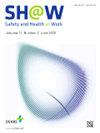Development and Application of Standard Codes for the National Exposure Surveillance System Utilizing Korea's Nationwide Exposure Database
IF 2.9
3区 医学
Q1 PUBLIC, ENVIRONMENTAL & OCCUPATIONAL HEALTH
引用次数: 0
Abstract
Background
The Work Environment Measurement Database (WEMD) is a valuable system for occupational exposure surveillance. However, its use is limited due to the lack of proper standardization of exposure-related variables. Hence, we developed a new standard process classification (SPC), standard occupation classification (SOC), and exposure condition category (ECOC) codes to establish an exposure surveillance system using the WEMD. Additionally, we assessed the feasibility of constructing a job-exposure matrix (JEM) using standardized codes.
Methods
The SPC and SOC were reclassified based on similarity from an exposure perspective, using established codes refined through reviews by industrial hygiene experts. The ECOC codes were based on the conceptual exposure assessment model. Ten experts conducted a pilot project to evaluate the applicability of the newly reclassified SPC, SOC, and ECOC codes.
Results
We developed 77 SPC, 82 SOC, and 12 ECOC codes, which were assigned to over 98% of the data by experts, demonstrating their practical applicability. A JEM linking industry, occupation, process, and exposure condition was constructed into an interactive dashboard based on expert evaluations, demonstrating feasibility and enabling better interpretation of exposure levels through user-controlled variables. Exposure levels varied significantly across ECOC groups, showing a clear linear trend with higher exposures in conditions representing greater exposure potential, such as proximity to the source and lack of control measures.
Conclusion
The newly developed standardized codes are easily applicable by industrial hygienists and can be integrated into the WEMD, supporting its expected use as an exposure surveillance system.
利用韩国全国暴露数据库的国家暴露监测系统标准代码的开发与应用
工作环境测量数据库(WEMD)是一个有价值的职业暴露监测系统。然而,由于缺乏与暴露有关的变量的适当标准化,其使用受到限制。因此,我们制定了新的标准过程分类(SPC),标准职业分类(SOC)和暴露条件分类(ECOC)代码,以建立使用WEMD的暴露监测系统。此外,我们评估了使用标准化代码构建工作暴露矩阵(JEM)的可行性。方法采用工业卫生专家审定的规范,从暴露角度根据相似度对SPC和SOC进行重新分类。ECOC规范是基于概念暴露评估模型制定的。10位专家进行了一个试点项目,以评估新重新分类的SPC、SOC和ECOC代码的适用性。结果共编制了77个SPC代码、82个SOC代码和12个ECOC代码,专家对98%以上的数据进行了分配,证明了它们的实用性。将行业、职业、流程和暴露条件连接在一起的JEM基于专家评估构建为交互式仪表板,展示可行性,并通过用户控制的变量更好地解释暴露水平。ECOC各组的暴露水平差异显著,在暴露潜力较大的条件下(如靠近源和缺乏控制措施)暴露水平较高,呈现出明显的线性趋势。结论新制定的标准代码易于工业卫生工作者使用,并可集成到WEMD中,支持其作为暴露监测系统的预期用途。
本文章由计算机程序翻译,如有差异,请以英文原文为准。
求助全文
约1分钟内获得全文
求助全文
来源期刊

Safety and Health at Work
Social Sciences-Safety Research
CiteScore
6.40
自引率
5.70%
发文量
1080
审稿时长
38 days
期刊介绍:
Safety and Health at Work (SH@W) is an international, peer-reviewed, interdisciplinary journal published quarterly in English beginning in 2010. The journal is aimed at providing grounds for the exchange of ideas and data developed through research experience in the broad field of occupational health and safety. Articles may deal with scientific research to improve workers'' health and safety by eliminating occupational accidents and diseases, pursuing a better working life, and creating a safe and comfortable working environment. The journal focuses primarily on original articles across the whole scope of occupational health and safety, but also welcomes up-to-date review papers and short communications and commentaries on urgent issues and case studies on unique epidemiological survey, methods of accident investigation, and analysis. High priority will be given to articles on occupational epidemiology, medicine, hygiene, toxicology, nursing and health services, work safety, ergonomics, work organization, engineering of safety (mechanical, electrical, chemical, and construction), safety management and policy, and studies related to economic evaluation and its social policy and organizational aspects. Its abbreviated title is Saf Health Work.
 求助内容:
求助内容: 应助结果提醒方式:
应助结果提醒方式:


